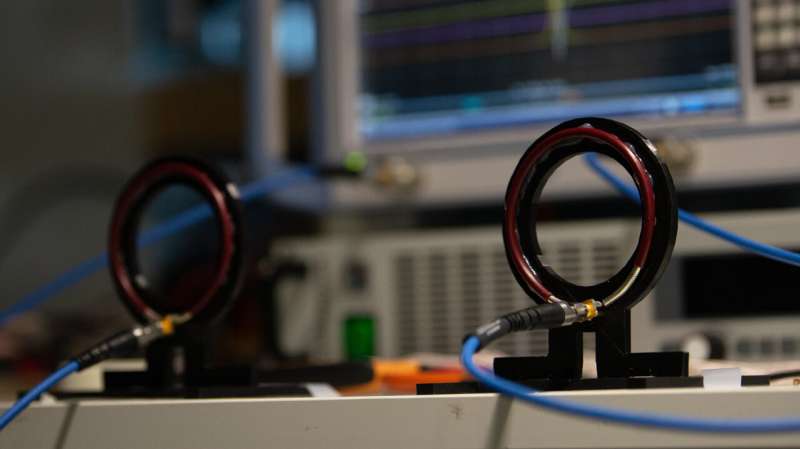
A better way to wirelessly charge over long distances has been developed at Aalto University. Engineers have optimized the way antennas transmitting and receiving power interact with each other, making use of the phenomenon of “radiation suppression.” The result is a better theoretical understanding of wireless power transfer compared to the conventional inductive approach, a significant advancement in the field.
Charging over short distances, such as through induction pads, uses magnetic near fields to transfer power with high efficiency, but at longer distances the efficiency dramatically drops. New research, now published in the journal Physical Review Applied, shows that this high efficiency can be sustained over long distances by suppressing the radiation resistance of the loop antennas that are sending and receiving power.
Previously, the same lab created an omnidirectional wireless charging system that allowed devices to be charged at any orientation. Now, they have extended that work with a new dynamic theory of wireless charging that looks more closely at both near (non-radiative) and far (radiative) distances and conditions. In particular, they show that high transfer efficiency, over 80%, can be achieved at distances approximately five times the size of the antenna, utilizing the optimal frequency within the hundred-megahertz range.
“We wanted to balance effectively transferring power with the radiation loss that always happens over longer distances,” says lead author Nam Ha-Van, a postdoctoral researcher at Aalto University. “It turns out that when the currents in the loop antennas have equal amplitudes and opposite phases, we can cancel the radiation loss, thus boosting efficiency.”
The researchers created a way to analyze any wireless power transfer system, either mathematically or experimentally. This allows for a more thorough evaluation of power transfer efficiency, at both near and far distances, which hasn’t been done before. They then tested how charging worked between two loop antennas positioned at a considerable distance relative to their sizes, establishing that radiation suppression is the mechanism that helps boost transfer efficiency.
“This is all about figuring out the optimal setup for wireless power transfer, whether near or far,” says Ha-Van. “With our approach, we can now extend the transfer distance beyond that of conventional wireless charging systems, while maintaining high efficiency.” Wireless power transfer is not just important for phones and gadgets; biomedical implants with limited battery capacity can also benefit. The research of Ha-Van and colleagues can also account for barriers like human tissue that can impede charging.
More information:
N. Ha-Van et al, Effective Midrange Wireless Power Transfer with Compensated Radiation Loss, Physical Review Applied (2023). DOI: 10.1103/PhysRevApplied.20.014044
Citation:
Engineers use radiation suppression to develop better wireless charging (2023, July 21)
retrieved 21 July 2023
from https://techxplore.com/news/2023-07-suppression-wireless.html
This document is subject to copyright. Apart from any fair dealing for the purpose of private study or research, no
part may be reproduced without the written permission. The content is provided for information purposes only.
Stay connected with us on social media platform for instant update click here to join our Twitter, & Facebook
We are now on Telegram. Click here to join our channel (@TechiUpdate) and stay updated with the latest Technology headlines.
For all the latest Technology News Click Here
For the latest news and updates, follow us on Google News.
